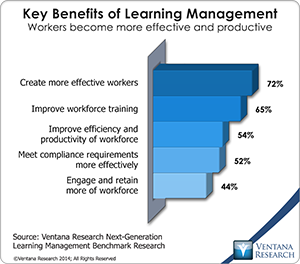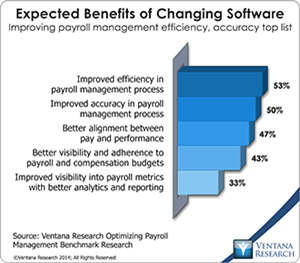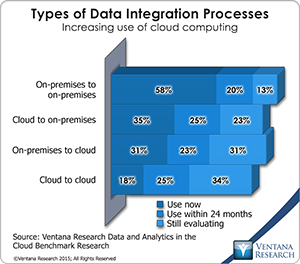Unifying Human Capital Management in 2016
Businesses and their human resource organizations feel pressure to maximize the value of their human capital in today’s intensely competitive world. Many have made or considered investments in new applications that better exploit information to efficiently recruit, engage and retain the best talent. Advanced applications not only advance these processes but also help management assess the performance of the workforce and compensate individuals fairly so that they advance their careers and find the level of employee satisfaction in the organization. A year ago I outlined the priorities in human capital management (HCM). During the past year our research found a significant number of companies lacking a unified HCM strategy that includes processes and the applications to support it. As others advance, HR organizations that are not equipped with such skills, resources and tools risk falling behind in human capital management as it contributes to business success.
A key step toward maximizing the potential of the workforce and providing the best possible employee experience is investing in self-service systems that enable both workers and managers to perform not just administrative tasks but also activities that are essential to their jobs. These range from scheduling online learning to prioritizing tasks and tracking them to completion to aligning them to performance goals. In addition HR departments can use these systems to enable employees to easily find answers to questions about their jobs, compensation,  benefits and other issues that matter to them. Whether established employees are transitioning to new roles internally or new ones are onboarding, the use of learning management systems can help them progress; this applies also to managers who need to expand their skills to move upward. Our research in next-generation learning management finds a resurgence in the use of learning systems. The most-often-sought benefit of investment in these systems, for almost three-quarters (72%) of organizations, is to create more effective workers; following that is improving workforce training (for 65%). Learning plays a key role in helping improve performance and the resulting appraisals, as I wrote about in depth. Despite HR industry banter about annual performance appraisals going away, the reality is that organizations need some type of scoring or grading to determine who qualifies for raises and promotions, and no matter how frequent the dialogues between managers and workers they need some type of objective assessment method.
benefits and other issues that matter to them. Whether established employees are transitioning to new roles internally or new ones are onboarding, the use of learning management systems can help them progress; this applies also to managers who need to expand their skills to move upward. Our research in next-generation learning management finds a resurgence in the use of learning systems. The most-often-sought benefit of investment in these systems, for almost three-quarters (72%) of organizations, is to create more effective workers; following that is improving workforce training (for 65%). Learning plays a key role in helping improve performance and the resulting appraisals, as I wrote about in depth. Despite HR industry banter about annual performance appraisals going away, the reality is that organizations need some type of scoring or grading to determine who qualifies for raises and promotions, and no matter how frequent the dialogues between managers and workers they need some type of objective assessment method.
At the same time, progressive organizations are embracing collaboration across the enterprise and adopting software to facilitate that. It helps the workforce interact socially to provide information or advice on specific actions. While collaboration may be a stand-alone application, we find it more effective to embed business collaboration as part of HCM applications in order to maintain the contexts of the business application or process. A collaborative approach to HCM can also reduce the volume of requests to the HR help desk. I highly recommend that you assess your HCM efforts to determine if you have placed the right level of collaboration that is digital in nature and can engage your employees to help them contribute back to the organization.
Collaboration is natural in a people-centric discipline like this, and so is the use of mobile devices. With so many people carrying smartphones and tablets, it makes obvious sense to expand them into business, but users expect mobile business applications to be as easy to use as their personal apps. Mobile technology has expanded further, to wearable technology for a variety of uses, which can be as simple as tracking one’s health in a fitness monitor or as businesslike as being notified of important information or necessary actions through a smart watch. For HCM specifically the technology so far has been mostly oriented to wellness to help workers gain situational awareness of their health and make personal improvements in the form of a game or through collaboration as a contest to improve the overall health of the organization, which is documented to improve the productivity and engagement of a workforce. The use of wearables in this regard can help demonstrate progress to healthcare providers and potentially limit rate increases.
Another related new technology of use to HCM is video. Available on almost every notebook or laptop computer and also on smartphones and tablets, it helps people interact with others and thus facilitates collaboration and engage the workforce in ways never possible before. Video has become essential for recruiting and interviewing, being the easiest way to meet and interview applicants and conduct the selection process far more efficiently and effectively than the old approach of reviewing resumes. Here again organizations that do not embrace video in both recruiting new workers and assessing those internally for new positions are at significant risk of being uncompetitive.
It goes without saying that compensation remains paramount in human capital management at both the salaried and hourly levels, and systems are available not only to ensure fair, competitive pay for employees but also to compare the organization’s practices to others in the industry. Benchmarking compensation internally to similar peers can help ensure equal pay for equal work and addressing diversity review especially in gender and race, which is critical not just to retain workers but also to avoid negative publicity that could arise from perceived biases and lack of thorough analysis. These applications are useful also for organizations that are investing in incentives and rewards to ensure that those who work and contribute to goals and targets are compensated appropriately and recognized in the organization. Compensation management must support recruiting and performance processes and any provider who does not allow for their compensation software to be assessed by itself might not be ready for your organization to utilize. Compensation must be funneled efficiently into payroll processes that are easy to operate and accessible to each individual. Many organizations recognize the need to provide visibility of employer-paid benefits on a total compensation statement that is always up-to-date and accessible. To track progress in this complex aspect of HCM we are conducting new benchmark research into the next generation of compensation management and also are assessing vendors and products in our 2016 Value Index.
Another area in human capital management where organizations are making significant improvement is workforce management. Advanced systems help them deal more  efficiently with daily time and attendance, absence and time off, labor scheduling and even time clocks. Improvements to the pay process also are common. Our payroll optimization benchmark research finds that integration with payroll and time and attendance topped the list of priorities in more than half of organizations, but the benefit most often achieved is improved efficiency, for 53 percent of organizations. This is a topic that we have researched thoroughly; it is explained in this analyst perspective. In 2016 we will be conducting new benchmark research into workforce management for human capital management, which I have written about. We are also assessing vendors and their products for our 2016 Workforce Management Value Index to determine which companies you should consider for your organization.
efficiently with daily time and attendance, absence and time off, labor scheduling and even time clocks. Improvements to the pay process also are common. Our payroll optimization benchmark research finds that integration with payroll and time and attendance topped the list of priorities in more than half of organizations, but the benefit most often achieved is improved efficiency, for 53 percent of organizations. This is a topic that we have researched thoroughly; it is explained in this analyst perspective. In 2016 we will be conducting new benchmark research into workforce management for human capital management, which I have written about. We are also assessing vendors and their products for our 2016 Workforce Management Value Index to determine which companies you should consider for your organization.
Workforce planning has also expanded to be more relevant and routine for your organization to utilize. HR should track a range of activities including head count, salary and organizational planning that are needed to understand the personnel budget and its impact on the organization. Workforce planning historically has a strategic focus and for many companies is focused on the annual budgeting process in conjunction with Finance, but to optimize it requires planning to be part of weekly operations, where insight on people-related activities is always available for comparing actuals vs. budget. Our next-generation business planning research shows that workforce planning is most important to 23 percent of organizations and second-most important to another 30 percent. Yet almost half (46%) of organizations use spreadsheets alone or with other applications, which our research repeatedly shows creates impediments to the planning process. But remember that workforce planning is the ability to model and plan the future and not just review information about the future.
A key tool for workforce planning is human capital analytics, which can produce metrics and key people indicators that effectively assess the processes, performance and potential risks related to the workforce. But many vendors show a dashboard of charts that maybe interesting but are not readily evident what to do and not able to take action on them which has the highest level of importance in 78 percent of our organizations according to our human capital analytics benchmark research. Look for analytics that are more than just a presentation but provide context and help make the information self-evident on what it means and what might be the steps needed to be taken. Organizations that take the engagement and retention of their workforce very seriously are applying predictive analytics to determine how likely candidates are to be engaged workers or which current workers are at risk of flight. Our latest research in predictive analytics found that only 15 percent of HR organizations use predictive analytics, but one in five said they are planning to use it by the end of 2016 and a little more than that are evaluating it. Related to workforce analytics is the use of big data regarding employees; the historical context of the workforce can be valuable, and our data and analytics in the cloud research finds that HCM or employee information is an important category in more than one-fifth (21%) of organizations.
For human capital management to progress, we believe it must become more unified with the enterprise resource planning (ERP) requirements that are led by Finance and the CFO. Having HR and finance leadership use a common set of applications and information can facilitate effective planning and performance across the organization. In many organizations, HR reports to the Office of Finance, but the two don’t work well together for a variety of reasons, in some cases due to the lack of consistency and availability of information from human capital management processes and applications. Over the last decade, the disparate nature of the applications supporting HCM has increased the need for HR and Finance to work in concert. This has led to a re-examination of the processing and supporting applications to identify a more unified and streamlined approach. Unifying the human resources management system (HRMS) and the supporting talent and workforce management applications can reduce duplication of efforts by creating a consistent employee master record and ensuring that policies and regulations are adhered to. This becomes essential especially to address a range of regulatory compliance requirements that should be more automated and a standard part of the HRMS systems. Organizations will have to look more closely to determine if the promises of vendors for an integrated approach for HR and accounting in ERP are a reality or part of a future roadmap. We expect to gain more insight on the overall direction with HRMS in our upcoming research, which I have described. One area of talent management that needs unification is the recruiting, hiring and onboarding steps that interface to the HRMS; organizations should have a seamless and engaging experience that guides a new hire to become an effective worker. Onboarding and engaging candidates and existing employees for new roles is where your organization can differentiate your employee experience and ensure you are setting a positive trajectory in your workforce. is We will investigate the next generation of talent management suites of applications that are not just more integrated and streamlined in performing activities but also how they integrate and in some cases include HRMS and payroll systems.
Many organizations use a disparate set of applications from different vendors that operate  on-premises and in cloud computing environments for human capital management; the only path to manage across these environments is application integration accompanied by data integration that unifies employee and related data for analytics and planning. As our data and analytics in the cloud research demonstrates, such integration is a growing point of need now and into 2017. Organizations should realize there is no such thing in just turning the light switch on and converting, and that the migration and time required can take some time. In any transition of applications and the ability to operate in a mixed vendor and computing environment should have a dedicated approach to using application and data integration. Thankfully some vendors are doing more than just providing lip service to this need and have partnered and in some cased embedded dedicated integration technology.
on-premises and in cloud computing environments for human capital management; the only path to manage across these environments is application integration accompanied by data integration that unifies employee and related data for analytics and planning. As our data and analytics in the cloud research demonstrates, such integration is a growing point of need now and into 2017. Organizations should realize there is no such thing in just turning the light switch on and converting, and that the migration and time required can take some time. In any transition of applications and the ability to operate in a mixed vendor and computing environment should have a dedicated approach to using application and data integration. Thankfully some vendors are doing more than just providing lip service to this need and have partnered and in some cased embedded dedicated integration technology.
If you have made it this far, you probably can tell that unifying HCM divide is no easy feat; most current environments offer many challenges. As pointed out in my recent digital technology business agenda for 2016, there has never been a better time to undertake a reorganization of HCM processes and systems. While many industry observers pontificate about HCM with little or no research behind them nor expertise in applying applications and information to business, we have outlined succinct steps that can help you can take immediate action to improve your efforts. It is not just about renting applications in the cloud and believing that it will magically work. As we have seen in the past with software that if it is not usable and manageable by business, it will not matter, and your evaluation and selection needs to be much more than looking at the vision and execution of vendors. If you do not have an HCM technology portfolio manager guiding your direction, please let me know. HR leaders should also work with finance and set a strategy for the right level of investment that like an insurance policy for your people will maximize the potential of your workforce. We can help ensure that your organization is not left behind in recruiting, engaging and retain the talent in the best possible employee experience and derive the optimal performance from every worker.
Regards,
Mark Smith
CEO and Chief Research Office
Authors:
Ventana Research
Ventana Research, now part of Information Services Group (ISG), is the most authoritative and respected market research and advisory services firm focused on improving business outcomes through optimal use of people, processes, information and technology. Since our beginning, our goal has been to provide insight and expert guidance on mainstream and disruptive technologies. In short, we want to help you become smarter and find the most relevant technology to accelerate your organization's goals.









